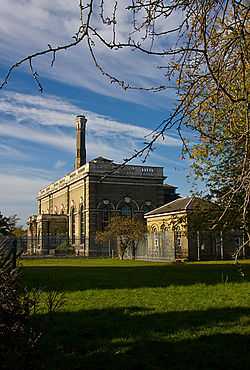Cricklewood Pumping Station

Cricklewood Pumping Station was built in 1905 to supply water to London's north west suburbs. It is situated at the eastern extremity of Gladstone Park, Cricklewood and is a locally listed building.
History
By 1900, about half of the sixty acre estate that had belonged to local industrialist, George Furness had been built on by housing developers. It was around this time that the New River Company bought some of the land for water works.[1] The pumping station built by the New River Company was initially responsible for providing all pre pumped water from the River Thames to London's expanding suburbs, some as far away as Hampstead and Hendon. Water was pumped up from the Thames via Cricklewood and stored in reservoirs including those in Golders Green and Muswell Hill.[2]
At the time that the pumping station was built, the majority of homes relied on rainwater cisterns and ponds. By the early twentieth century though, companies began supplying water to houses. In the Willesden area, the West Middlesex Waterworks Company supplied water to homes until 1903 when the Metropolitan Water Board took over. The Metropolitan Water Board had reservoirs at Harlesden Road and one at St. Michael's Road, Cricklewood, the same road as the pumping station.[3]
Water arrived at Cricklewood Pumping Station from Kempton Park Pumping Station. Two triple-expansion steam engines would pump 19 million US gallons (72,000 m3) of water a day via Cricklewood to North London.[4]
Cricklewood Pumping Station was coal-fired until the 1950s and the distinctive 135 feet (41m) tall chimney was used to discharge smoke. By the late 1950s, the station had converted to electric power, rendering the chimney obsolete. In 1987, the station attained notoriety when a pipe burst leaving the surrounding streets so badly flooded that residents had to be evacuated.[5]
Current Use
In 1978, Cricklewood Pumping Station became the Cricklewood works of the Thames Water Authority, now Thames Water Utilities Ltd, and has remained in use ever since. The defunct chimney has found a new lease of life as a mobile phone mast.
Popular Culture
The interior of Cricklewood Pumping Station was used as a double for the Titanic's engine rooms twice, most recently in 1997 film, Titanic" and previously in the Kenneth More film A Night to Remember.
References
- ↑ Ashdown, Ind. Mon. of Gtr. Lond. s.v. Brent.
- ↑ http://middlesexcountycouncil.org.uk/index.php?option=com_content&task=view&id=16&Itemid=35
- ↑ http://www.british-history.ac.uk/report.aspx?compid=22607
- ↑ http://www.mankymonkeymotors.co.uk/Photos/kemptonpumpingstation09/words.html
- ↑ http://www.ukattraction.com/london/cricklewood-pumping-station.htm